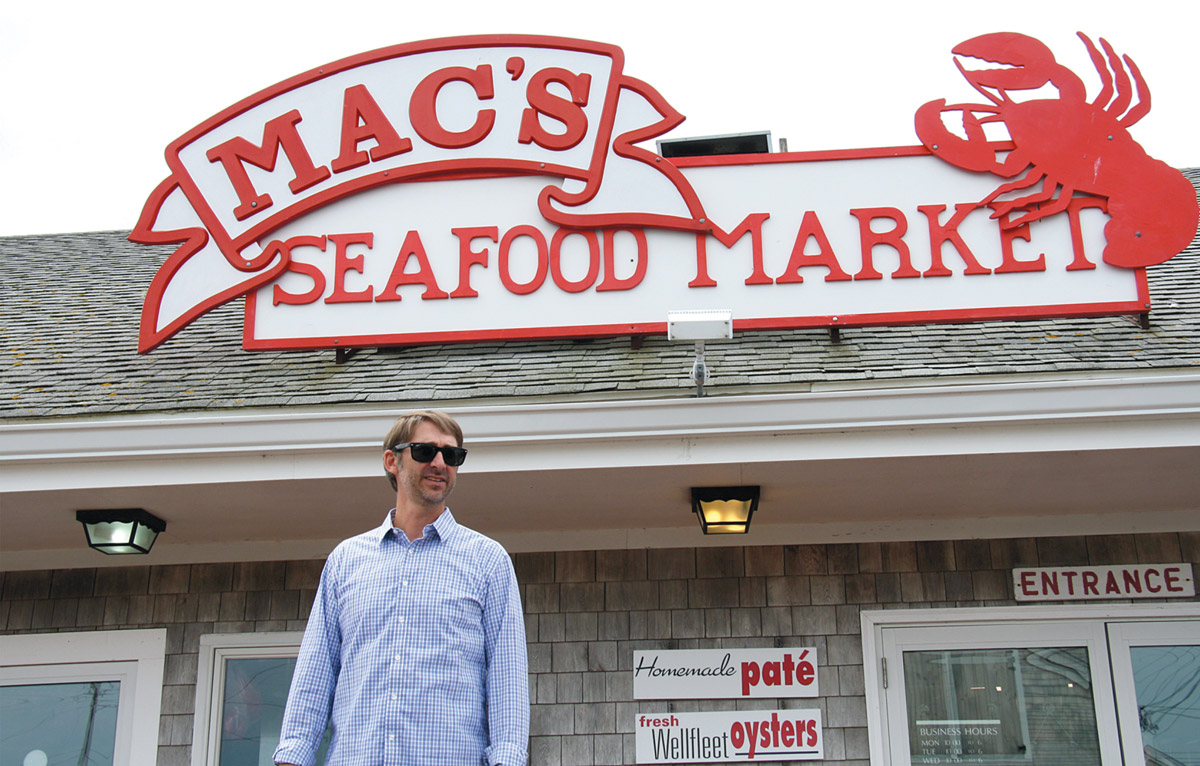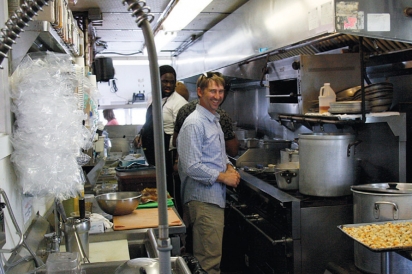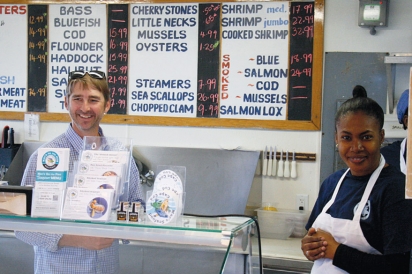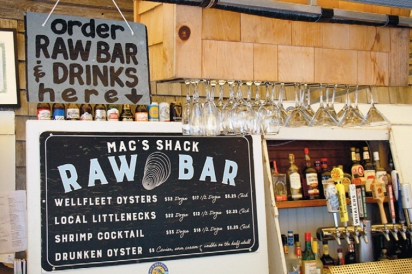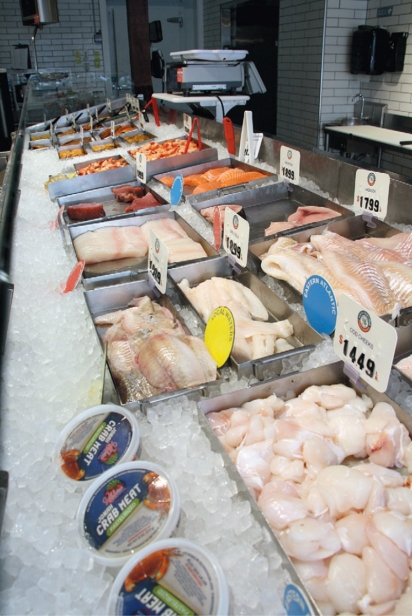Mac Hay, The Fishing Philosopher
Cori and I are driving down Commercial Street in Wellfleet on a late April afternoon when a figure ambles across the road in front of us. Hands jammed into his pockets and hat pulled low over his brow, his sinewy frame has a gait of someone lost in thought. “I think that’s him,” Cori said as we pull into the empty crushed shell parking lot of Mac’s Shack, quiet in the off-season. I step out of the car and approach. “Larry?” asks the gentleman. “Mac?” I respond. “Nice to meet you.” This strolling fellow is Mac Hay, owner and founder of Mac’s Seafood. His layers of fleece, jeans, two-day-old scruff, and most of all, youthful appearance run contrary to the image some have of the head of a corporation with over four hundred employees, five restaurants, five fish markets, a wholesale division, and a newly-acquired seafood wholesaler, The Lobster Trap in Bourne.
“Tensions are high,” Mac calmly states as we walk to his second-floor office above his wife Traci’s art studio behind Mac’s Shack. Why wouldn’t they be? In less than twenty-four hours, Mac’s Shack would open its doors for the nineteenth year, and getting everything just right to create that sought-after dining experience enjoyed by so many takes a lot of work by many hands. Perhaps his composed demeanor stems from the fact that he’s been at it a long time. That his phone isn’t lighting up with urgent calls, texts, and emails says he’s got the right team taking care of things.
Born and raised in Wellesley, Massachusetts, Mac’s grandparents – along with a group of friends – purchased property in Truro where Mac and his family would spend their summers. As the teenage years arrived, Mac went to work. “I worked at The Busted Shutter,” he chuckles at the memory. “That’s a name that’ll take people back a few years.” At eighteen years old, he took a summer job from Carol Larson at Harbor Freeze on the sand adjoining the Wellfleet Town Pier. Since the 1950s, Harbor Freeze had been a place families visited for that truly Cape Cod experience of fried seafood, ice cream, and toes in the sand. The next year, Carol had Mac managing the place. The year after, she offered to sell Harbor Freeze to Mac. At the tender age of 20, Mac opened Mac’s on the Pier in 1995. “She was ready to retire, and offered it to me,” Mac remembers. “When you’re that age, you’ve got nothing to lose.” When he puts it that way, he can almost make purchasing a dining establishment before he could legally buy a beer seem normal.
“I was a sophomore in college, and I had a total of $5000,” he explains. “I borrowed $500 from ten different people. I paid them all back double in two years. I wanted to make sure I didn’t have any other shareholders.” The growth of the business has been fueled by his belief in it. “Whenever I got a little bit of equity in the business, I’d take it out and put it right back into the business.” It was his way to finance Mac’s Seafood while eschewing outside infusions of cash. “The beauty of starting a business when you’re twenty is you can live on five or six thousand dollars a year,” he chuckles. “And in the restaurant business, all my food was covered. I just had to come up with rent, and I split that with four or five roommates.”
“When I got into this business, I thought I’d open up, make a million bucks in two months, and take ten months off,” Mac laughs. “I thought this was easy street! Little did I know… ” The reality set in, and the true operating schedule and cash flow of a seasonal restaurant on Cape Cod revealed itself. “The mortgages pile up, debt starts piling. You learn what it takes to survive a winter. You get comfortable taking out a line of credit to make it to mid-July when you finally get in the black.” It’s something that would test anyone’s faith in their business plan. Despite having grown to the size the company is today, the conviction Mac has still needs to be rock solid. “I mean, you run more than half the year in the red. You have to believe that the future will happen yet stay so present to focus on what you’re doing now to not let that distract you.” And on Cape Cod, things are magnified. “Our highs are higher, and our lows are lower. There’s a great lesson to be learned in that. When you go through those lows, the highs are higher,” he says. “It’s a great sense of accomplishment when you get through a summer after a particularly brutal winter.”
While studying philosophy at Colgate, Mac looked to other methods of educating himself. “Colgate didn’t have a business management program, so I looked for ways of advancing my executive thinking,” he points out. Working at the nearby Hamilton Inn, or (after college) working winters on St. John, the Manhattan Ocean Club, and restaurants in the Boston area gave him crucial lessons that he brought back to his own business. “I was focused on recipes, and technique of food,” Mac says. “Then it dawned on me that kitchens are about systems.” The procedures with which a kitchen operates can mean the difference between chaos and calmness during the height of dinner service. Hay’s passion is food, and he will still gravitate to the back of the house and the cooking line where the action is. “When I’m engaged in cooking at the restaurant or at home, the rest of the world just melts away,” he admits. “It’s a focus, even if you’re cooking four dishes, you don’t need to time things because you know it, you just feel it.” He found out that his way of doing things was not so repeatable when it came time to train others. “I learned that I like to work outside the normal systems.” Trying to get his kitchen teams on board with his unorthodox methods proved to be challenging. The difficulty for Mac was how to develop systems that didn’t include him. Enter into the picture: a tick.
“When I was micro-managing every recipe, I’d tell them how or show them how to do something, but not write it down,” he explains. “I’d say, ‘It’s easy. I’ve done it a hundred times.’ Problem is it’s their first time.” It wasn’t until Mac contracted Lyme disease that he was forced to create systems with him removed from the equation. Ironically, this was the point when the business really began to grow. “I learned so much about the business when I was removed from it,” he marvels. Had everything continued to run through Mac, the ceiling for Mac’s Seafood would have been a lot lower. Mac’s executive chef, Scott Robertson, oversees the restaurants. Operations Manager, Jared Chianciola, and Chief Financial Officer Sam Bradford (Mac’s cousin) are two more vital members of the talented team he has assembled to bring Mac’s Seafood to where it is today.
Starting in 2006, Mac’s Seafood really began to blossom with the opening of Mac’s Shack up the street from the pier in Wellfleet. The following year saw the opening of their original Eastham location (since moved to a different spot on Route 6) Mac’s Market & Kitchen Eastham. Mac’s Fish House (and adjoining market) Provincetown, and Mac’s Chatham Fish & Lobster came along several years later. Along the way, Mac and his team faced challenges. Early on, the idea of locally caught seafood needing to be shipped off-Cape to a processing plant only to return ready to sell went against what Hay’s team was trying to do: Provide their customers with the freshest, locally caught finfish and shellfish available. Obtaining a wholesaler license meant Mac’s Seafood could buy directly from the fishermen, process the catch at one of their facilities, and get it to the plates of their customers far faster than previous methods. Mac’s younger brother Alex took point on getting the proper accreditations to be HACCP (Hazard Analysis Critical Control Points) certified. In 2011, the organization took over Wellfleet Shellfish Company (WSC), another HACCP-approved wholesaler. Alex has since gone on to take full control of WSC separately from Mac’s Seafood.
The latest acquisition happened two years ago when Logan Clark was ready to step down from The Lobster Trap, the Bourne-based wholesaler he started in 1973. “We had been clients of The Lobster Trap for years,” Mac says. “Logan kind of tricked us into it,” he adds with a laugh. With the purchase, the footprint of Mac’s Seafood within the local seafood economy grows significantly. Along with the Bourne headquarters location, The Lobster Trap has three wharves in Machiasport in Downeast Maine. Packaging and shipping all types of seafood around the world, it’s the lobsters that they’re known for. The Lobster Trap supplies local restaurants and markets as well as larger ones such as Whole Foods and Stop & Shop. For Mac, it’s taking further control of his supply chain, and planning for the future. “With climate change, we’re seeing product (fish species) moving North,” he explains. The motto of Mac’s Seafood is one that the organization is always working to answer. Now, with the addition of The Lobster Trap, they’re even more poised to “Know Where Your Fish Comes From”.
When it comes to lobster, one of the most frequently asked questions Hay gets is, “Why are they so expensive?” Hay responds, “It’s the global competition. Chinese buyers are paying good money for them.” This leads us into the larger picture of pricing and seafood wholesaling. The seafood industry is unique when it comes to prices. “It’s crazy,” Mac explains. “We don’t set the price we buy our products for, and we don’t set the price we sell them for. It’s all market driven. The industry is a relationship business. You need to know the person and trust the person you’re buying from.” Mac continues, “After all, you can’t send it back.”
Hay, like owners of businesses large and small, must take it all in. “I study things on the holistic scale, but also the minute level as well. Fisherman, wholesaler, retailer, customer – it’s amazing how many things go into delivering that piece of bass to a table,” he marvels. “And the path for it to be right is extremely narrow!” Hay understands that food is emotional. People must have a connection to it, and the setting goes a long way in creating that connection. “Food doesn’t happen in a box,” he explains. “The vibe has to be just right. The music too loud and the lights too low? It’s off. The music too low the lights too bright? It’s off.” People come to Mac’s Shack, for example, to experience an exceptional meal but also the ambiance of being under the tent at the bar when things get jumping or at coppertop tables on the crushed shells. For Mac, those choices were made from necessity. “I used copper because it was the cheapest material nineteen years ago.” That Yankee ingenuity continues today. “I couldn’t bring myself to buy lightbulbs the other day. I knew we had six of them somewhere and wanted to use them first.” The ability to analyze the operating systems throughout the organization on the macro and micro scale has helped Mac’s Seafood become a go-to choice for Cape Codders and visitors alike. Whether it’s for a clam roll at a picnic table in the sand in Wellfleet or the wonderfully inventive seafood creations of Mac’s Shack, the Fish House in Provincetown or Chatham Fish & Lobster, the efforts of so many people working as a finely-honed team shines through. “The work gives us a sense of real purpose – you don’t grow your business by cutting corners. We pay people as much as we can. We buy the best products, and serve them at the best prices we can,” he points out. Guests have responded as they return year upon year. “It’s generational,” he says with a sense of humility. “It’s a real privilege.”
For information on each location:


